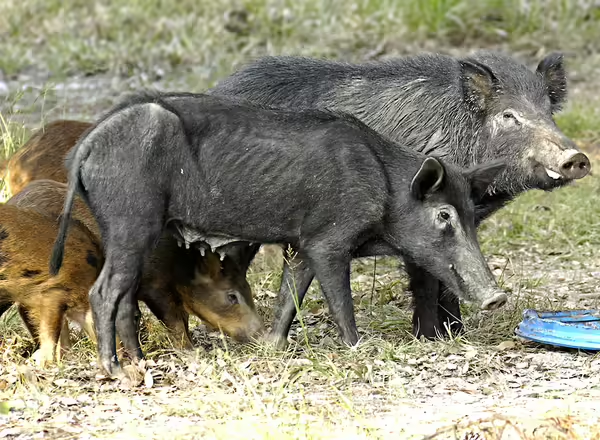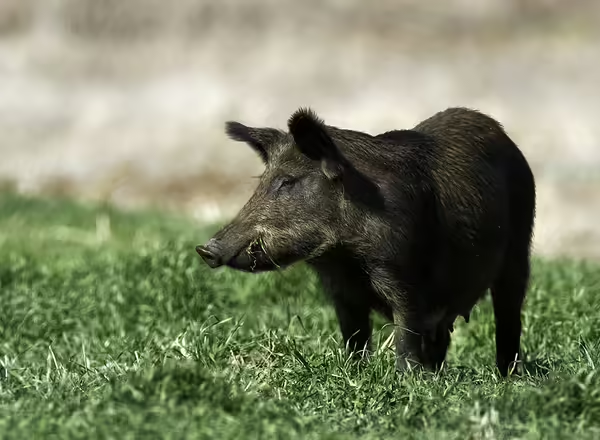
Feral Swine
With no natural predators and a high reproduction rate, feral swine (Sus scrofa) are one of the most serious and damaging invasive mammals in the U.S. Like domestic swine, their feral counterpart roots for tubers and small animals destroying native habitats. This causes direct impact on the habitat and their predation creates competition with local wildlife for resources.
Commonly known as feral swine, feral hogs, wild pigs, razorback, or wild boars, IL Admin Code Part 700 defines feral swine as populations or individual swine that are unrestrained and have adapted to living in a wild or free-forming environment. Free ranging swine are not under domestic confinement. In 2014, Illinois, prohibited the barter, sale, release, hunting, and guiding of feral swine hunts. The Illinois Department of Natural Resources and U.S. Department of Agriculture have been able to remove all known feral swine in Illinois as they occur.

Feral swine live in groups called sounders. As opportunistic omnivores with rooting and wallowing behaviors, swine uproot the vegetation and soil increasing soil erosion and sedimentation which effect water quality. One example of potential ecosystem destruction would be in wetlands. Wetlands are critical in an ecosystem for holding and neutralizing water as well as for their biodiversity. If a large sounder of swine finds this habitat full of food, they could destroy it in one night eliminating endangered plants and animals.
Nationwide, feral swine cause more than $2.5 billion in damages and control costs a year. Feral swine carry more than 30 viral and bacterial diseases. They are host to 37 parasites that affect people, pets, livestock, and other wildlife. Because they are very mobile there is concern for disease transmission from feral to commercial swine, which would have serious impact on the pork industry and the U.S. economy. Samples taken from feral swine removed from Illinois tested positive for pseudorabies, swine influenza, toxoplasmosis, trichinosis, and leptospirosis. In addition, pasture and row crop farmers have had increased equipment damage post feral swine rooting through fields.
History of Feral Swine
Originally native to China and Europe, Hernando de Soto brought America's first 13 pigs to Tampa Bay, Florida in 1539. Currently, feral swine originate from dumped pets, those released or escaped from traditional hog operations, or intentional releases. Human interest in game hunting increased illegal shipping of swine into Illinois as well as other states.
Regulation of Feral Swine
In 2011 the Illinois Department of Natural Resources, IDNR, and The Wildlife Society, TWS, collaborated on an integrated damage management program to assist landowners in the removal of feral swine. In 2014, IDNR with the support of TWS, Illinois Farm Bureau and the Illinois Department of Agriculture, prohibited the barter, sale, release, hunting, and guiding of feral swine hunts in Illinois. The IDNR and U.S. Department of Agriculture are the primary authorities responsible for enforcing the regulations.

Feral swine look like domesticated swine. The upper and lower canines of the boar curve backward and outward making the skull unique. Domesticated pigs who may have recently escaped confinement can be mistaken for feral swine.
Though they vary in size, depending on their ancestry, feral swine tend to be intermediate in size, between the domestic pig and the European wild hog. Feral swine are leaner than domestic swine and vary in size and weight. Swine have four toes on each foot of which two contact the ground. They have 44 teeth. The coat is commonly black but other colors such as brown, spotted black or brown, or black and white are not uncommon. Swine have a dense course coat.
Feral swine are generalists. They can live in any habitat, limited only by temperature in colder regions. Swine prefer habitat cover for protection but may forage in open habitats at night. Swine are omnivorous as well as generalist consumers. Under ideal conditions, adult sows can breed up to twice a year with 5 to 10 piglets per litter. Juveniles may begin reproducing at 6 to 8 months of age. Their reproductive rate is rapid and offspring numbers can be high.
With no natural predators and a high reproduction rate, feral swine are one of the most serious and damaging invasive mammals in the U.S. In states, not Illinois, where they are working on controlling the population, 60% to 70% of the population must be removed annually just to keep the population from increasing and remain stable.
Illinois wants to keep swine out of the state and the goal is to identify and eliminate any population discovered. Corral traps, aerial control, and hunting have been successful.
The IDNR and USDA have been able to remove all known feral swine in Illinois as they occur.
Do not bring feral swine into Illinois. If you see a free roaming pig of any type, contact the Illinois Department of Natural Resources.
More Resources
- Naturalist News, Feral Swine: Potentially the most invasive species yet
References
- USDA, APHIS, Feral Swine-Managing an Invasive Species